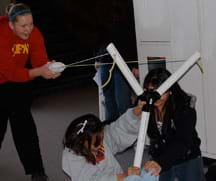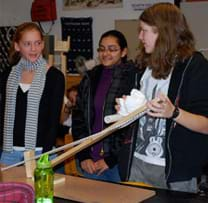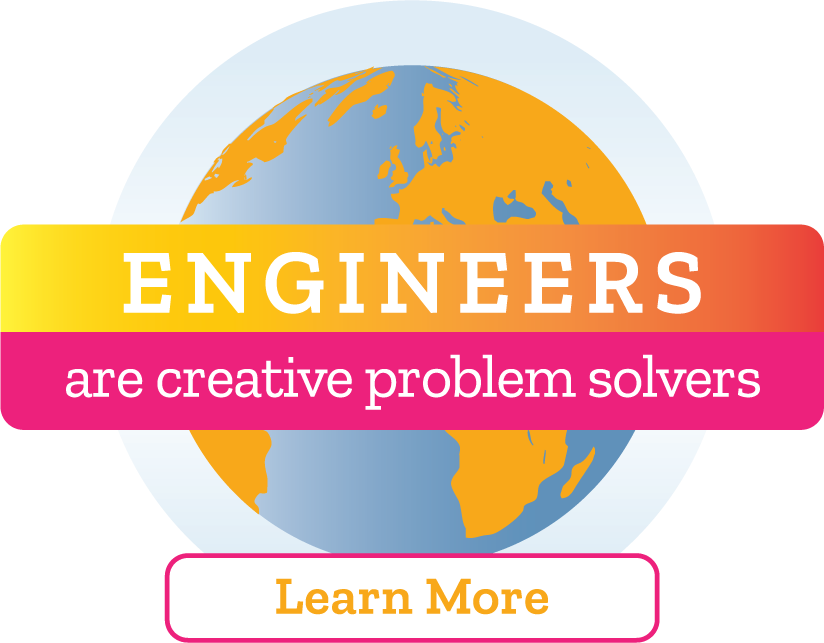Quick Look
Grade Level: High school; also scalable for middle school
Time Required: 10 hours (wild guess!)
(10 hours)
Subject Areas: Problem Solving

Maker Challenge Recap
Students are challenged to find a way to get school t-shirts up into the stands during sporting events. They work with a real client (if possible, such as a cheerleading squad, booster club or band) to determine the requirements and constraints that would make the project a success, including a budget constraint. They think “outside of the box” to come up with lots of ideas. Then they mock-up small-scale model(s) of their best, most feasible ideas for testing, before making full-scale usable devices that they further refine and then demonstrate and deliver to the client. They use the engineering design process to complete this challenge.
Maker Materials & Supplies
- sketching and prototype building materials such as paper and pencils, tape, scissors, glue, fabric, craft sticks, plastic drinking straws, paperclips, string, rubber bands, twist ties, scraps, recycling bin materials
- full-scale model building materials such as wood (dowels, 2 x 4s, plywood), PVC pipes and joints, hardware (nails, screws, hinges, springs), elastic tubing, bungee cords, canvas, grommets, rope
- an assortment of fabrication tools and adhesives such as saws, drill and bits, sandpaper, duct tape, wood glue, screw drivers and screws, hammer and nails, twine
- computer with Internet access, to show an inspirational eight-minute online video
Worksheets and Attachments
Visit [www.teachengineering.org/makerchallenges/view/cub_tslauncher_maker1] to print or download.Subscribe
Get the inside scoop on all things TeachEngineering such as new site features, curriculum updates, video releases, and more by signing up for our newsletter!More Curriculum Like This

During this engineering design/build project, students investigate many different solutions to a problem. Their design challenge is to find a way to get school t-shirts up into the stands during home sporting events. They follow the steps of the engineering design process to design and build a usabl...
Kickoff
[Modify the introductory paragraph below to match your school and the client(s) you may have set up in advance; or else make this a hypothetical challenge.]
During our high school’s football and basketball games, our cheerleaders want to throw school t-shirts into the crowd during game breaks. The problem is that they do not have a way to get the shirts way up into the top rows of the bleachers from the playing field and court. The cheerleading coach has asked our class to create some device(s) to help them out.
All engineering designs start with a need or a problem to solve. For example, practical solar panels were engineered when companies like NASA needed a way to power satellites in space. The Internet was born when the U.S. military needed a way to communicate between computers. Here, our client needs a way to get a t-shirt high into the bleachers during games and pep rallies. So now what do we do? As engineers, how do we go about designing something to meet our client's need?
[Show students an inspiring eight-minute ABC News Nightline video called "The Deep Dive" that showcases an engineering design firm going through this creative step as they entirely rethink a shopping cart in order to design an improved one. See https://www.youtube.com/watch?v=M66ZU2PCIcM.]
This video shows us how “out of the box” creative thinking can benefit engineering design solutions. Who knows how alligator clips were invented? These little devices temporarily connect two or more wires and they look like little jaws holding the wires together. How do you think someone came up with the idea? As the story goes, when a team was brainstorming, one engineer said something about training mice to bite down on the wire ends to hold them together. Although the idea seemed silly at the time, it led to the development of alligator clips, which work like mice biting down on the ends of two wires!
To get started, working in your team, find out everything you can about the project requirements and limitations from the client. What might be some constraints? (Constraints are what engineers call a project’s requirements and limitations. Examples might be maximum budget, easy to use by two people, maximum distance, accuracy to a certain distance, safe to use, made of specific materials, easy to transport in a backpack, easy to assemble/disassemble, durable, reliable, able to launch items besides t-shirts, ease of repair, uses commonly available replacement parts, finished in school colors, etc.)
Next, come up with some great ideas—and then select the best idea to pursue, making sure it meets the constraints. You will want to do lots of testing and improving to make it a good solution for your client. Let’s get going!
Resources
Refer to the Engineering Design Process hub on TeachEngineering to guide your students through the challenge.
If students have a real client who plans to use the device, it greatly increases student interest in the project and the quality of their designs. Consider arranging for a real-world client(s) in advance, or have groups find their own; otherwise, make it a hypothetical challenge. Clients might be the cheerleading squads for various school athletic teams, booster clubs, parade float committees or bands—groups that want to be able to throw t-shirts, candy or swag to crowds.
Show students an eight-minute video from ABC News Nightline about IDEO's innovation design process; make sure students watch the brainstorming process around minute 4; see https://www.youtube.com/watch?v=M66ZU2PCIcM. IDEO is an engineering design and innovation firm known worldwide for exploring deeply and thinking creatively to find unique solutions to design challenges.
Maker Time
Expect designs to vary greatly even though many are variations on the ideas of catapults, slingshots and crossbows. You may want to implement a strict budget and limit the potential materials students can request to basic supplies available at hardware, grocery and/or dollar/discount stores.

Prompt students to do their own research on concepts related to the problem, such as potential and kinetic energy, object shapes and air resistance, launch angle, conversion of elastic potential energy to kinetic energy, conversion of gravitational potential energy to kinetic energy, and materials properties.
Emphasize the importance of thinking “outside of the box,” and the engineering design process:
- Kick off brainstorming by suggesting some wild ideas like hiring a football pro to throw the shirts up into the stands or using a radio-controlled toy helicopter or drone to fly the shirts up into the upper bleachers or modifying a tennis ball machine to shoot t-shirts. Then guide them to narrow their ideas to what is feasible and meets the constraints. (T-shirt “guns” are commercially available but are costly.)
- Prompt students to work through the engineering design cycle using the Engineering Design Process Notebook to record constraints, ideas, plans, deadlines, reminders and test results.
Consider creating some interim deadlines to keep the team projects moving forwards, such as preliminary design check, first/quick/small-size prototype testing, detailed design/final design plan (with detailed drawings and materials list), full-size prototype testing, final product presentation with user guides.
Wrap Up
Hold a test day in which all teams go outside or to the gym to demonstrate their devices in the presence of the client(s). Wrap up with a class discussion in which students reflect upon the final devices, sharing their observations and thoughts about the final products and suggestions for more advanced refinement.
Copyright
© 2017 by Regents of the University of ColoradoContributors
Denise W. CarlsonSupporting Program
Integrated Teaching and Learning Program, College of Engineering, University of Colorado BoulderAcknowledgements
This maker challenge was inspired by the Flying T-Shirt activity that was created by the Integrated Teaching and Learning Laboratory in the College of Engineering and Applied Science at the University of Colorado Boulder.
Last modified: July 27, 2020






User Comments & Tips